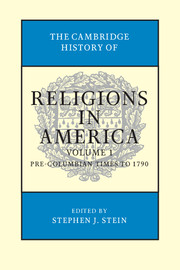Book contents
- Frontmatter
- Contents
- Contributors
- Editor's Introduction
- SECTION I BACKGROUND ON RELIGIOUS TRADITIONS – PRE-1500S
- SECTION II RELIGIONS IN THE POST-COLUMBIAN NEW WORLD – 1500–1680S
- 6 Iroquoian Religion during the Seventeenth Century
- 7 Mississippian Religious Traditions
- 8 The Anasazi
- 9 Spanish Catholicism in the Era of Exploration and Early Colonization
- 10 French Catholicism in the Era of Exploration and Early Colonization
- 11 English, Dutch, and Swedish Protestantism in the Era of Exploration and Early Colonization
- SECTION III RELIGIOUS PATTERNS IN COLONIAL AMERICA – 1680S–1730S
- SECTION IV RELIGIOUS DIVERSITY IN BRITISH AMERICA – 1730S–1790
- SECTION V AMERICAN RELIGIONS IN THE EIGHTEENTH-CENTURY INTERNATIONAL CONTEXT
- SECTION VI THEMATIC ESSAYS
- Index
- References
6 - Iroquoian Religion during the Seventeenth Century
from SECTION II - RELIGIONS IN THE POST-COLUMBIAN NEW WORLD – 1500–1680S
Published online by Cambridge University Press: 28 July 2012
- Frontmatter
- Contents
- Contributors
- Editor's Introduction
- SECTION I BACKGROUND ON RELIGIOUS TRADITIONS – PRE-1500S
- SECTION II RELIGIONS IN THE POST-COLUMBIAN NEW WORLD – 1500–1680S
- 6 Iroquoian Religion during the Seventeenth Century
- 7 Mississippian Religious Traditions
- 8 The Anasazi
- 9 Spanish Catholicism in the Era of Exploration and Early Colonization
- 10 French Catholicism in the Era of Exploration and Early Colonization
- 11 English, Dutch, and Swedish Protestantism in the Era of Exploration and Early Colonization
- SECTION III RELIGIOUS PATTERNS IN COLONIAL AMERICA – 1680S–1730S
- SECTION IV RELIGIOUS DIVERSITY IN BRITISH AMERICA – 1730S–1790
- SECTION V AMERICAN RELIGIONS IN THE EIGHTEENTH-CENTURY INTERNATIONAL CONTEXT
- SECTION VI THEMATIC ESSAYS
- Index
- References
Summary
The early colonial period of the sixteenth and seventeenth centuries was a time of trauma and devastation for Iroquoian peoples and territories. The historical record of that period is as dramatic and stunning as it is flawed. From the time of first direct contact with Europeans in the 1530s, Iroquoians have been subjects of interest to European writers, largely for reasons of power. In the early seventeenth century a large body of writing about the Iroquoians began developing under the pens of French Jesuit missionaries, whose aims were to destroy Iroquoian and other indigenous religions. Known collectively as the Jesuit Relations, in subsequent centuries these writings became the primary source documents for knowing and understanding Iroquoian life in the seventeenth century. Important English and Dutch sources exist as well, but they are far smaller in size and scope. The Jesuit Relations were compiled and translated in the early twentieth century into seventy-three volumes. Other important sources for Iroquoian religion during the seventeenth century include indigenous oral traditions, archaeology, linguistics, and later ethnographic research from the nineteenth and twentieth centuries.
The famous “League of the Iroquois” included five different indigenous nations that were united into a permanent league or confederation, arranged through an Iroquoian set of principles known as Gayanashagowa, the “great law of peace.” The names of these nations are usually given as the Mohawk, Oneida, Onondaga, Cayuga, and the Seneca. In the early eighteenth century, a sixth nation was added, the Tuscarora.
- Type
- Chapter
- Information
- The Cambridge History of Religions in America , pp. 111 - 136Publisher: Cambridge University PressPrint publication year: 2000



